Mice



Types Of Mice
House Mouse: Small and light brown or gray, the house mouse is the most common type found in homes. It has a slender body, large ears, and a long tail. They typically measure 7.5-10 cm in length, excluding the tail, and their size allows them to squeeze through tiny gaps.
Deer Mouse: Slightly larger than the house mouse, deer mice have white underbellies and brownish bodies. They are more common in rural areas or around the edges of cities but can occasionally invade homes.
Mice Behavior
Nesting Habits: Mice prefer warm, hidden spaces near food sources to nest. They often build nests inside walls, attics, basements, or even inside furniture, using soft materials like paper, fabric, or insulation.
Foraging: Mice are nocturnal and tend to forage for food during the night. They are attracted to easily accessible food, especially grains, fruits, and scraps.
Reproduction: Mice reproduce rapidly, with a single female capable of giving birth to 5-10 litters per year, each with 5-6 young. This rapid population growth can quickly turn a small problem into a major infestation.
Signs of Infestation
Droppings: Mice leave behind small, pellet-like droppings, often found near food sources, under sinks, or along baseboards.
Gnaw Marks: Mice chew on various materials to keep their teeth sharp, leaving behind noticeable gnaw marks on wires, wood, and food packaging.
Scratching Noises: You may hear scratching or scurrying sounds, particularly at night, as mice move within walls or ceilings.
Nests: Finding a small nest made of shredded materials like paper or fabric is a strong indicator of mice presence.
Foul Odor: The buildup of urine and droppings can create a musky odor, especially in enclosed areas like basements or attics.
Dangers/Concerns
Health Risks: Mice can spread diseases, including Hantavirus and Salmonella, through their droppings, urine, and saliva. They contaminate food and kitchen surfaces, posing a risk to human health.
Property Damage: Mice gnaw on wires, insulation, and wood, leading to potential fire hazards and structural damage. Their nesting habits can also cause damage to insulation and other soft materials.
Prevention Tips
Seal Entry Points: Mice can squeeze through gaps as small as a dime. Inspect your home’s exterior and seal any cracks or holes in the foundation, walls, or around utility lines and vents.
Eliminate Food Sources: Keep food in airtight containers, clean up crumbs and spills, and ensure that garbage bins have tight-fitting lids. Don’t leave pet food out overnight.
Declutter: Mice like to hide in cluttered areas such as basements, attics, and garages. Reducing clutter will give them fewer places to nest.
Trim Vegetation: Keep bushes, shrubs, and tree branches trimmed away from your home to reduce access points.
Treatment Options
DIY Methods: Set traps around areas of activity, such as along baseboards or behind appliances. Use snap traps, glue traps, or live traps, depending on your preference. Baits can also be placed in safe, secure areas where children and pets cannot access them.
Professional Services: AZ Pest Control offers humane and effective solutions to eliminate mice infestations. We perform a thorough inspection, seal entry points, and place bait stations or traps in strategic locations. We also provide follow-up visits to ensure the problem is fully resolved.
Why Choose AZ Pest Control
At AZ Pest Control, we understand the urgency and risks associated with mice infestations. Our team provides fast, reliable, and humane services tailored to your specific situation. With eco-friendly solutions and preventative measures, we help you keep your home mice-free for the long term. Our follow-up visits ensure complete eradication and peace of mind.
